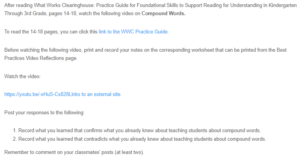Video Reflection – Compound Words
The video affirms my prior knowledge of compound words. Compound words are combinations of two words that form one word that is independent and meaningful. For instance, the words “sun” and “flower” combine to form “sunflower.” I acknowledge words can be blended to form compound words, while compound words can be segmented to form two words. Previously, I have interacted with compound words through their formation. Based on the video, I affirm the blending of compound words is easier compared to their segmentation, which subjects a person to challenges of understanding the specific independent words that combine in the compound words. Indeed, blending and segmenting compound words depends on phonemic awareness and letter sounds, which helps one connect letters to form specific words (Institute of Education Sciences, 2016).
Initially, I believed that all students require similar skills when learning about compound words. However, the video states that some students do not require similar skills in blending and segmenting compound words. Hence, a need arises for educators to integrate differentiated instructions to accommodate all students in the learning activities and address their needs to achieve the same level of understanding for all students. Teachers can use Elkonin sound boxes to help students identify specific sounds in a word (Foorman et al., 2016). The teacher can also group the students in pairs or in small groups, where students can interact and share their ideas on how to understand and determine sounds in a word, which helps them understand the correct words, making a compound word for ease of segmentation. Educators should acknowledge the different potentials and abilities in their classrooms to incorporate the best teaching strategies that align with the class needs and ensure no students are excluded or fail to acquire relevant skills in a lesson content due to the teaching method used.
References
Foorman, B., Beyler, N., Borradaile, K., Coyne, M., Denton, C. A., Dimino, J., & Wissel, S. (2016). Foundational skills to support reading for understanding in kindergarten through 3rd grade. Educator’s practice guide. NCEE 2016-4008. What Works Clearinghouse.
Institute of Education Sciences. (2016, September 14). Video 11: Compound words [Video]. YouTube. https://www.youtube.com/watch?v=-xHuS-Cx828
ORDER A PLAGIARISM-FREE PAPER HERE
We’ll write everything from scratch
Question
After reading What Works Clearinghouse: Practice Guide for Foundational Skills to Support Reading for Understanding in Kindergarten Through 3rd Grade, pages 14-18, watch the following video on Compound Words.

Video Reflection – Compound Words
To read the 14-18 pages, you can click this link to the WWC Practice Guide.
Before watching the following video, print and record your notes on the corresponding worksheet that can be printed from the Best Practices Video Reflections page.
Watch the video:
https://youtu.be/-xHuS-Cx828Links to an external site.
Post your responses to the following:
- Record what you learned that confirms what you already knew about teaching students about compound words.
- Record what you learned that contradicts what you already knew about teaching students about compound words.
Remember to comment on your classmates’ posts (at least two).


